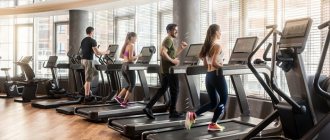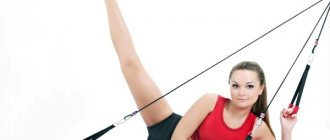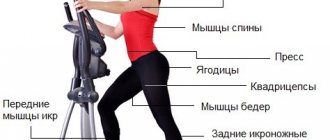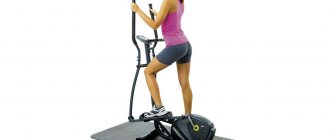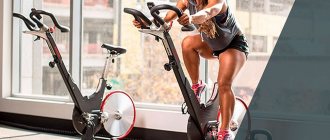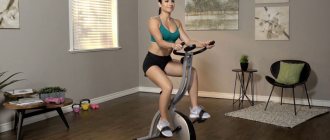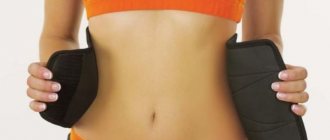Everyone has heard about how beneficial cycling is. Unfortunately, not everyone has the opportunity to do it, so an alternative such as an exercise bike comes to the rescue. Such exercise machines are available in gyms. They are also available for purchase and use at home. If you learn how to properly exercise on an exercise bike, you can both lose excess weight and build muscle in your legs.
Basic rules of training
How to exercise on an exercise bike correctly to lose weight and get a slim figure?
It would seem that there is nothing complicated about this - sit down and pedal. However, a systematic and competent approach to training will bring much more benefits than intensive training on a bicycle machine depending on your mood. The following parameters are decisive for successful training:
- Technique and body position;
- Load range and determination of optimal heart rate;
- Monitoring indicators;
- Equipment (clothing);
- General rules of fitness.
Let's look at the main points in more detail.
Technique
The main criterion for technically correct training is the position of the back during exercise. Don't arch your lower back too much, as many beginners do. The back should be kept in a natural and relaxed position, a slight rounding of the shoulders is allowed.
You need to relax your hands: you should not put the main weight on them. The feet should be parallel to the floor, and the knees should be directed forward or slightly inward to achieve uniform muscle load. Keep your head straight, as if you are driving along the road and look ahead. And be sure to adjust the seat height!
Optimal load range
Exercises on an exercise bike will only benefit the body if the range of loads matches your capabilities
During training, it is important to take into account your own sensations and monitor your heart rate. To lose weight, you should choose a medium intensity level: the pedals of the device should rotate quite easily
If the load is increased, the training time will be reduced. To lose weight, you need to pedal for at least 30 minutes, otherwise the fat burning process will not start.
The most important indicator is heart rate. First you need to calculate the maximum heart rate, then find out the optimal heart rate zone, which will allow you to carry out the most effective exercises on an exercise bike for weight loss and body shaping. At the warm-up stage, the heart rate should not exceed 60% of the maximum value; at the main stage of training, the heart rate should correspond to 65-75% of the maximum.
Monitoring indicators
Always track your heart rate, distance traveled and other indicators provided by the machine's computer. Experts advise keeping a detailed training log: this will allow you to achieve maximum productivity from your workouts. Write down the training time, the number of calories burned, your own feelings, and weight readings. This way you can more clearly evaluate the results of the exercises.
Equipment
A T-shirt and special cycling shorts are ideal for training, making it easier to fit and not interfering with movement. Some people use special gloves for close contact with the steering wheel. Shoes should have hard soles for good fixation: slippers and sandals are not suitable for intense pedaling. Comfortable sneakers or sneakers will do.
General rules
These rules are known to everyone, but for some reason some people forget about them:
- Control your breathing - breathe evenly and always through your nose;
- Don’t start without warming up: joints, ligaments and muscles need to be warmed up before loading;
- Do not stop the training abruptly: do a so-called “cool-down”, which helps the heart move from a high frequency of contractions to a normal one;
- Do not start exercises if you feel unwell or weak.
The duration of training and the level of load should correspond to the goals and physical capabilities. If you exercise on a machine to lose weight, one session should take at least 40 minutes. Work out while listening to music - this way your workouts won't seem too boring.
Training program
The main condition for successful cycling training is regularity. You can start with training for 20 minutes, gradually increasing the duration to 45 minutes, and then to 60. The frequency of training is at least 3-4 times a week.
There are two types of loads: uniform and interval. A uniform load implies the same pace throughout the entire session; with an interval load, intense pedaling alternates with a calm pace. Practice shows that it is interval training on an exercise bike that provides the most optimal result for body correction and weight stabilization.
Approximate interval training scheme:
- 5-10 minutes – warm-up (rotate the pedals in a comfortable mode, simultaneously stretching your arms).
- Speed up for 30 seconds - maintain a medium pace and control your breathing.
- Maximum intensity load for 30 seconds - maintain the fastest pace in the load range.
- Alternate between the calm phase and the intense phase several times.
- 10-15 minutes – cool down.
This pace allows you to reduce the total training time and achieve a more pronounced effect.
What muscles work on an exercise bike?
- Quadriceps (front surface of the thigh) are the muscles responsible for bending the legs at the knees. When lifting the hip towards the abdomen and then straightening, this function is activated when the pedals are made in a circular motion.
- The muscles of the back surfaces of the thighs are designed to straighten the pelvis from tilting on straight legs, bending the legs at the knees and rotating the shins. When moving from the abdomen, the thigh stretches; when the knee bends, the heel moves towards the buttock. This is done by applying pressure to the pedals and making circular movements.
- The buttock muscles work together with the quadriceps during cycling training. Exercises improve the appearance of the buttocks, making them more attractive.
- The area of work of the muscles responsible for flexing the hips (lumbar and iliacus) is the lower abdomen and upper thighs.
- Exercises help strengthen the lower back muscles, they become more elastic, posture is corrected, and the spine is healthier. This simulator can relieve minor manifestations of scoliosis and even prevent the occurrence of osteochondrosis and radiculitis.
- Located in the calves of the legs, the soleus and gastrocnemius muscles are used when bending the leg and extending the foot, putting pressure on the pedal.
- The location of the tibialis anterior muscle is the front of the lower leg. Designed for flexion of the feet.
- Cycling also puts stress on the abdominal muscles, or more precisely, on the rectus abdominis muscle. Strong abs are important for maintaining balance and leaning, maintaining a straight back, and producing strength.
- Classes involve not only muscles, but also joints: hip, knee, ankle, preventing the development of neuralgia, arthrosis, radiculitis and osteochondrosis.
Benefits of an exercise bike
Why this particular mechanism? Doctors say:
- Health. Exercising on this simulator strengthens the cardiovascular system and brings blood pressure back to normal. In other words, the risk of strokes and heart attacks is reduced.
- Metabolism. Exercise on an exercise bike will help your metabolism. As a result, calorie consumption per day increases.
- Losing weight. This is an aerobic type of exercise. In just one hour of intense training, you can lose up to 500 calories, and this is a third of your entire diet for the day.
- Physical attractiveness. Regular exercise will help strengthen the muscles of the abdomen, legs, and buttocks.
What other “advantages” are there in exercise on exercise bikes?
- Develops leg muscles.
- Helps improve joints, ligaments, and prevents injuries.
- Strengthening the respiratory and cardiovascular systems.
- Stress relief. If you don't exercise intensively, you can relax after nervous tension.
- Figure correction.
No matter what type of exercise bike you use, you can achieve very good results.
The benefits of cardio training for the heart and blood vessels
An exercise bike is an excellent option for training the whole body, but the most primary factor here is cardio, that is, strengthening the cardiovascular system and training the heart:
- Strengthening the heart muscle. Regular training minimizes the possibility of developing various pathologies and heart diseases, and in general the circulatory system becomes healthier.
- Prevention of pathologies. Competent exercises are an excellent way to prevent thromboembolism, hypertension and other ailments.
- Functional reserve of the heart. The result of training is a clearer and more measured pulse. As you know, trained people generally have a less intense pulse compared to untrained people, and they breathe more deeply and rarely. The reason for this is precisely cardio training. Thanks to exercise, the heart works much more stable, and the load on the heart is reduced. This way the overall work reserve increases, you extend the period of functioning of this muscle.
Cardio training perfectly strengthens blood vessels and develops the circulatory system. In order to supply tissues with oxygen, more different parts of the circulatory system are involved - as a result, the body begins to work more efficiently. Let us remind you that a beneficial effect is achieved only with competent training and measured loads, and the benefits and harm to the heart are a purely individual concept.
Selection rules
You should select a training device for your home based on your goals and the individual characteristics of the athlete who will be using it.
When choosing an exercise bike, you need to pay attention to the following:
- Weight. The lighter the unit, the easier it is to move it, but training on such a machine will be a little more difficult. And also, if the exercise machine has a lot of weight, it will be more stable and the exercises will be more comfortable.
- Flywheel rotation. The flywheel is a disc that provides resistance to the rotation of the pedals, thereby creating a load during training. It must rotate smoothly and have a mass of at least 7 kg.
- Load system. Some units make unpleasant noise, and this is not very good if you practice at home. The electromagnetic or magnetic load system eliminates unpleasant sound. The size of the simulator body also saves from noise: the larger it is, the less noise.
- Programs. Modern models have different training programs that help achieve different goals.
- Adjustment. Each athlete has individual characteristics, so the unit must be easy to change the position of the saddle and handrails.
- Cardiac telemetry. All new models are equipped with sensors to measure heart rate and body load. For comfort during exercise, they should be located in convenient places.
The parameters of the exercise bike model directly depend on your goals, so in order to:
- strengthen blood vessels and improve heart function; the unit should have a pulse meter, a load control system, and a log;
- relieve stress and tension - smooth movement and additional functions that diversify your workout;
- lose weight – heavy load (flywheel with high mass).
When you have decided on the goals and main parameters of the model, before directly purchasing an exercise bike in the store you need to:
- Test its operation as with any car: you need to sit on it and pedal a little.
- Choose models from well-known manufacturers, if finances allow.
- View the maximum weight that the machine can support.
- Check the ease of fastening the feet on the pedals so that they do not rub and hold your feet securely during exercise.
If you take into account all the above tips, you can choose the most suitable exercise machine for use at home.
Test its operation, as with any car: you need to sit on it and pedal a little
Features of classes for various diseases and conditions
After evaluating the benefits of cycling aerobics, most likely you will want to exercise. Just keep in mind that in addition to these, there are other restrictions:
During pregnancy and breastfeeding
Spinbike classes during pregnancy planning are very important.
These workouts strengthen the body and are quite acceptable within reasonable limits. During pregnancy (especially in the first trimester), such training is not recommended. You should not go to a cycling studio while breastfeeding.
It is best to limit yourself to simpler activities: walking or something similar.
For sore knees
In the initial stages of arthritis and arthrosis of the knee joint, an exercise bike is even prescribed as a preventive measure for the knees, but we are talking about a simple exercise bike and fairly light workouts, but not a bike.
Serious pain in the knees, consequences of injuries, etc. make it possible to train only at an easy pace and only after consulting a doctor. In general, cycling training, where body position often changes and high loads are used, is not the best option for those who have problems with knee joints and who have pain in their legs. In this case, if your knee joints are painful, it is better to choose a simple exercise bike.
For varicose veins of the legs
Is it possible to exercise with varicose veins? Classes are possible only in the initial stages of the disease, even before the appearance of varicose veins. You definitely need to look at your body's reaction. For the first 4-6 weeks, you should train on light-intensity programs and only then (if the disease does not progress) switch to moderate loads.
When the disease is quite serious and especially due to age, you should completely abandon such intense training.
For a sore back
If the body is in a more or less static position, then during exercise the load on the back is practically removed. If the training is performed only while sitting, then the back is in a position as if “along the ground.” Light static load strengthens stabilizer muscles and is useful for hernias and curvatures. If you have back pain, you need a special recumbent exercise bike.
Here you should pay attention to two main parameters:
- degree of disease - with scoliosis (stage 1-2), with protrusions or herniation of the spine (intervertebral hernia), such exercises are not allowed;
- training program – with frequent changes of body position and significant loads, back problems are a limitation to training.
If the disease is at an early stage, then with moderate and light loads you can take up weight training.
For other diseases
We note such diseases as:
fibroids - with fibroids you need to train with extreme caution, it is better not to use normal cycling, regardless of the location of the nodes, with this disease it is necessary not to significantly increase the pulse and not to put stress on the abdominal muscles;
high blood pressure - if you have high blood pressure, it is better to start with physical therapy and exercise on simple exercise bikes, and continue with cycling;
vegetative-vascular dystonia - exercises are not recommended for VSD, since cycling has many symptoms that negatively affect VSD; only light independent training is possible, but short and in combination with other various activities;
diseases of the thyroid gland - if you have a thyroid problem, exercise is possible, but only under careful self-control and with regular examinations;
diseases of the respiratory system - at significant stages of the disease, intense stress can only worsen the ailments, however, in the initial stages and with psychosomatic ailments, they may well be useful;
endometriosis – with endometriosis, you need to limit exercise during menstruation and not make training stressful, that is, for the most part, train for your own pleasure without excessive stress.
In conclusion, cycling is not a workout for everyone. For the most part, these activities are only for healthy people. They are available for some ailments, but for the most part only at light intensity.
Also check out the video below:
Overall, these activities have a lot of benefits and help you achieve many different goals. We hope that this material has created additional interest in cycling and brought you benefits.
What are the health benefits of an exercise bike?
An exercise bike exposes the body to severe stress and, because of this, has a number of contraindications:
1. Heart problems: heart failure, heart disease, angina pectoris, tachycardia.
2. Severe diabetes mellitus.
3. Infectious diseases.
4. ARVI and influenza.
5. Period of exacerbation of chronic diseases.
When there are no obvious contraindications, whether it is worth training on an exercise bike is decided based on the state of the body and well-being.
If you experience shortness of breath, difficulty breathing or chest pain, nausea, weakness or dizziness while exercising on an exercise bike, stop exercising.
In the first place, harm from exercising on an exercise bike occurs when there is insufficient attention to the body and the symptoms it demonstrates; in second place is an incorrect training regimen. Choosing a program of inappropriate complexity or overloading will not bring health benefits.
The consequences for these cases are sure to affect the body:
1. Training despite contraindications leads to aggravation of the disease and the appearance of additional complications.
2. Overtraining leads to physical and mental exhaustion, which causes depression, loss of strength or injuries associated with sprains and joint problems.
The disadvantages of an exercise bike include one advantage: since the exercise bike is located indoors, the time spent in the fresh air is reduced, which negatively affects health. Replace the exercise bike with jogging or cycling, weather conditions permitting.
An exercise bike does not cause harm to the body; problems begin when the rules of use are not followed.
How and how much you need to train at home to lose weight using an exercise bike
Losing weight with an exercise bike - general principles:
- exercise 3 to 6 times a week;
- one lesson should last at least 30 minutes;
- the heart rate should be between 70 and 80% of the maximum level, which is 220 minus the person’s age;
- Practice interval training, it is more effective for burning calories.
Easy ride
Technique:
- Sit on the exercise bike that is customized for you and place your hands on the handlebars.
- Straighten your body, tighten your stomach.
- Place your feet on the pedals with the middle of your feet, or insert your feet into the special mounts on the pedals.
- Start pedaling with your feet.
- The movement should occur due to the tension of the leg muscles, and not due to the transfer of body weight.
- Spin the pedals one at a time without jerking, maintain an even pace.
- Do not put your body weight forward on your hands.
Video: How to exercise correctly to lose weight on an exercise bike
Easy driving with high load
Technique:
- Set the exercise bike to high load.
- Start pedaling.
- Maintain a straight body and correct leg position, otherwise you risk injury.
- Do not help yourself pedal with your body weight, do not move your body to the sides and do not help with your hands.
- There should be no pain in your knees.
- You can choose any speed available to you under high load.
- You can lean forward a little to simulate riding a racing bike.
Video: Riding while seated with a high load
Driving fast while standing
Technique:
- Take the starting position on the exercise bike, making sure that your feet are stable on the pedals.
- Stand with your straight legs vertical above your feet.
- Secure your hands on the steering wheel.
- Make sure that your pelvis does not sway left and right and that your back does not hunch.
- Do not raise your shoulders up and try to transfer the main load to your legs.
Video: Fast driving while standing
Slow riding while standing
It simulates climbing a mountain. Technique:
- Take the starting position on the exercise bike.
- Set the load to high.
- Stand with your feet on the pedals and grip on the steering wheel.
- Pedal at a slow pace, paying attention to the position of your legs and body. To avoid damaging your joints, tighten your hips and buttocks.
Video: Slow riding while standing with a high load
Easy driving at a fast pace
This ride simulates descending from a mountain. Technique:
- Take the starting position on the exercise bike.
- Set to low resistance or low load.
- Pedal at a fast pace.
- Light workload and fast pace do not mean you can relax. Make sure that the body does not bounce on the seat or swing from side to side.
Outwardly, this kind of riding does not differ from simple riding, but in terms of load, cardio predominates in it.
Video: Fast riding while sitting
Rises while driving
Technique:
- Take the starting position on the machine.
- Choose from two options: high load and low pace or low load and high pace.
- After 30 seconds, stand up and continue pedaling while standing without interrupting your workout.
- Change the position of the body in this way every 30 seconds, this will give additional stress to the buttocks.
Video: Alternate riding standing and sitting
Handlebar push-ups
Technique:
- Take the starting position on the exercise bike while standing.
- Start pedaling at your chosen pace.
- Keeping your body straight and without slowing down, bend your arms and inhale, bringing your chest closer to the steering wheel.
- Without stopping at the bottom, as you exhale, straighten your arms, pushing yourself back to the starting position.
- Maintain the selected driving pace at all times.
- Perform push-ups only from a standing position.
Interval training on an exercise bike: how to build
* Determine your workout heart rate zones.
“When it comes to interval training, it makes sense to focus specifically on the pulse,” insists Anastasia Yatsyna. — Otherwise, the idea of “intensive” and “weak” load is subjective and very arbitrary. You may underestimate her and simply not be able to cope with the class. Or overestimate and not get any benefit from it. To avoid mistakes, calculate your maximum heart rate (using the formula 220 minus age). During intense work, your heart rate (HR) should be in the zone of 70-80% of the maximum; during rest, it should be approximately 50% of it.” Buy a heart rate monitor and rely on its readings.
* To increase the load and move to intense work, increase the resistance or speed.
The first method is more suitable for well-trained athletes and allows you to work your leg muscles. The second one can be recommended for those who are weaker. “In this case, the resistance needs to be reset, but not to zero,” says Anastasia Yatsyna. — To adjust the load, first turn it all the way to “idle”, then increase it until you feel a slight grip on the road. It is with this clutch that you will pedal as quickly as possible, bringing your heart rate to a high level. And rest with a little more resistance.”
* Listen to yourself.
The given heart rate indicators are not a reason to necessarily catch up with your heart rate to them. “If you quickly run out of steam while pedaling at a heart rate of 70% of the maximum value, do not raise it even higher, to 80%,” says Anastasia Yatsyna.
* Vary the time of intense work and rest.
Is it difficult to withstand 60 seconds of intense exercise? Reduce this interval to 30-40 seconds. 75 seconds of rest were not enough to restore breathing, increase this time by another 15-20 seconds. Start the next push only when you are ready for it. But it is better to leave the number of cycles (8-12) unchanged.
As, by the way, is the case if an intense workout on an exercise bike seems too easy to you. The expert does not advise in this case to further increase the load, further increasing the heart rate, reducing the rest time and increasing the duration of high-speed jerks. “When you study according to the Little-Gibal scheme, you get quite sufficient load,” emphasizes Anastasia Yatsyna. — They’re just well prepared. In this case, it is better to include other interval training in your schedule, for example on the elliptical or treadmill.”
Service details
The main points are:
- Cleaning. For cleaning, it is advisable to use a cotton cloth and a mild soap solution. The display can be cleaned with distilled water and a soft, clean cloth to avoid leaving streaks.
- Lubrication. The components of the exercise bike are initially lubricated, but after several months of use the lubrication should be repeated.
It is recommended to check and lubricate the moving parts of the exercise equipment every three months. The instructions for each specific type of simulator provide a detailed diagram of how to lubricate correctly.
Attention! Before each of these procedures, be sure to unplug the equipment by removing the plug from the outlet.
Benefits and contraindications for training
An exercise bike can be compared to a medical pacemaker, since it puts an excellent load on the heart muscle, which helps strengthen it. With the right load and training regimen, you can count on losing weight. By understanding how to use a home exercise bike correctly, you can independently achieve a beautiful and inflated figure and maintain a high level of health.
Benefits of homeschooling
Important, that:
- during home exercises on this sports machine it is almost impossible to get injured, since the risk of falling and colliding with other traffic participants who can be met on the street is zero;
- such training is not contraindicated for people with joint or spine problems;
- there is no need to waste time and money on going to the gym;
- there is an opportunity to study in any free time;
- you can not depend on the weather;
- there is no need to purchase special shoes or any other equipment used for safety (for example, if you ride a bicycle on the street, you need a bicycle helmet);
- The exercise bike can be compactly placed in any room and even on the balcony.
Modern exercise bikes have built-in computer equipment with the ability to monitor indicators such as:
- pulse;
- calories burned;
- accumulated kilometers.
And also for proper distribution of muscle and cardio loads, it is possible to set a convenient intensity mode using an odometer that measures wheel revolutions. Modern sports devices are designed in such a way that anyone can achieve results by exercising on them, even if their sports activities started from scratch and are at a minimum level.
https://youtube.com/watch?v=MoRPx82ykuQ
What are the benefits of an exercise bike?
Exercise on an exercise bike is a separate type of aerobic exercise, in which:
- the functioning of the cardiovascular system improves (an exercise bike is also called a cardio exercise machine);
- the activity of the heart muscle and lungs is stimulated;
- the body is cleansed of waste and toxins;
- blood circulation improves;
- the respiratory system develops;
- weight loss effect is achieved;
- blood pressure normalizes;
- salt deposits in the lumbar and cervical spine are dispersed.
For men, exercise on an exercise bike is useful because it allows you to:
- pump up leg muscles;
- gain an attractive body contour;
- develop endurance and strength of the body.
The benefits of classes for women are as follows:
- you can remove excess fat from the sides;
- there is a real opportunity to tighten your hips and buttocks, make your figure slim and fit;
- You can fulfill your long-standing desire and get rid of cellulite.
The results of regular cycling training meet all expectations, since the exercise bike not only burns fat and excess calories, but also transforms them into the necessary vital energy. The benefits of such exercises for the heart and general strengthening of the body on a cardio machine are obvious. But we must not forget about contraindications.
